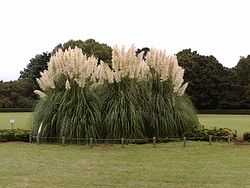Cortaderia selloana
| Pampas Grass | |
|---|---|
 | |
| Pampa grass inflorescences (Cortaderia selloana) in a garden, France. | |
| Scientific classification | |
| Kingdom: | Plantae |
| (unranked): | Angiosperms |
| (unranked): | Monocots |
| (unranked): | Commelinids |
| Order: | Poales |
| Family: | Poaceae |
| Genus: | Cortaderia |
| Species: | C. selloana |
| Binomial name | |
| Cortaderia selloana (Schult. & Schult.f.) Asch. & Graebn. | |


Cortaderia selloana, commonly known as pampas-grass,[1] is a flowering plant native to southern South America, including the pampas after which it is named.
It is a tall grass, growing in dense tussocks that can reach a height of 3 m (10 ft). The leaves are long and slender, 1–2 m (3 ft 3 in–6 ft 7 in) long and 1 cm broad, with very sharp edges. The leaves are usually bluish-green, but can be silvery grey. The flowers are produced in a dense white panicle 20–40 cm (8–16 in) long on a 2–3 m (6 ft 7 in–9 ft 10 in) tall stem.
The specific epithet was given by Josef August Schultes and Julius Hermann Schultes in 1827, after the German botanist and naturalist Friedrich Sellow, who studied the flora of South America, especially that of Brazil.
Cultivation and uses

The plant was introduced to Europe, North America and Australia as an ornamental grass, and, to a lesser extent, to provide food for grazing animals. The feathery flower head plumes, when dried, are widely used in flower arrangements and other ornamental displays.
There are several cultivars available, including:
- 'Albolineata' — a small cultivar which grows to only 2 m (6.6 ft) in height. The leaves are variegated, with yellow edges.
- 'Aureolineata'agm[2]
- 'Pumila'agm[3]
- 'Sunningdale Silver'agm[4] — grows to a height of 4 m (13.1 ft) and has particularly dense flowering plumes.
Those marked agm have gained the Royal Horticultural Society's Award of Garden Merit.
Pampas grass is highly adaptable and can grow in a wide range of environments and climates. It also seeds prolifically, with each plant able to produce over one million seeds during its lifetime. As such, in some areas (for example California, Hawaii or Green Spain) it is regarded as an invasive weed, whilst in New Zealand and South Africa the plant is banned from sale and propagation for the same reasons. Burning pampas grass does not always kill it at the roots, but chemical weedkiller does.
Swinging
A widespread urban myth is that pampas grass is used by swingers to advertise their presence to other swingers in the area. The most commonly repeated version states that in the UK and Ireland a patch of pampas grass is planted somewhere in the front garden to act as a signal to passersby that swingers live in the home. [5] [6] [7] [8] [9] [10]
References
- ↑ "BSBI List 2007". Botanical Society of Britain and Ireland. Archived from the original (XLS) on 2015-02-25. Retrieved 2014-10-17.
- ↑ "RHS Plant Selector - Cortaderia selloana 'Aureolinata'". Retrieved 16 June 2013.
- ↑ "RHS Plant Selector - Cortaderia selloana 'Pumila'". Retrieved 16 June 2013.
- ↑ "RHS Plant Selector - Cortaderia selloana 'Sunningdale Silver'". Retrieved 16 June 2013.
- ↑ Walker, Tim (2010-12-02). "Esther Rantzen: Swingers in Luton? That's life". Telegraph. Retrieved 2012-01-22.
- ↑ "Fashionable foliage - The Irish Times - Sat, Oct 02, 2010". The Irish Times. 2010-10-10. Retrieved 2011-12-06.
- ↑ "Tales Of The Country: A year in Herefordshire - Brian Viner, Columnists - The Independent". web.archive.org. 2010-11-01. Archived from the original on 2010-11-01. Retrieved 2012-01-22.
- ↑ "BBC News - Frostrup 'did not realise pampas plants advertised swinging'". bbc.co.uk. 2011-11-30. Retrieved 2012-01-22.
- ↑ "TV presenter discovers pampas grass on balcony is a signal to swingers". smh.com.au. 2011-11-30. Retrieved 2012-01-22.
- ↑ Murray Wardrop (2011-11-30). "Mariella Frostrup accidentally invites swingers with pampas grass". Telegraph. Retrieved 2012-01-22.
External links
| Wikimedia Commons has media related to Cortaderia selloana. |
| Wikispecies has information related to: Cortaderia selloana |